The 14 Most Iconic Trees Native to Vermont
7. Northern White Cedar
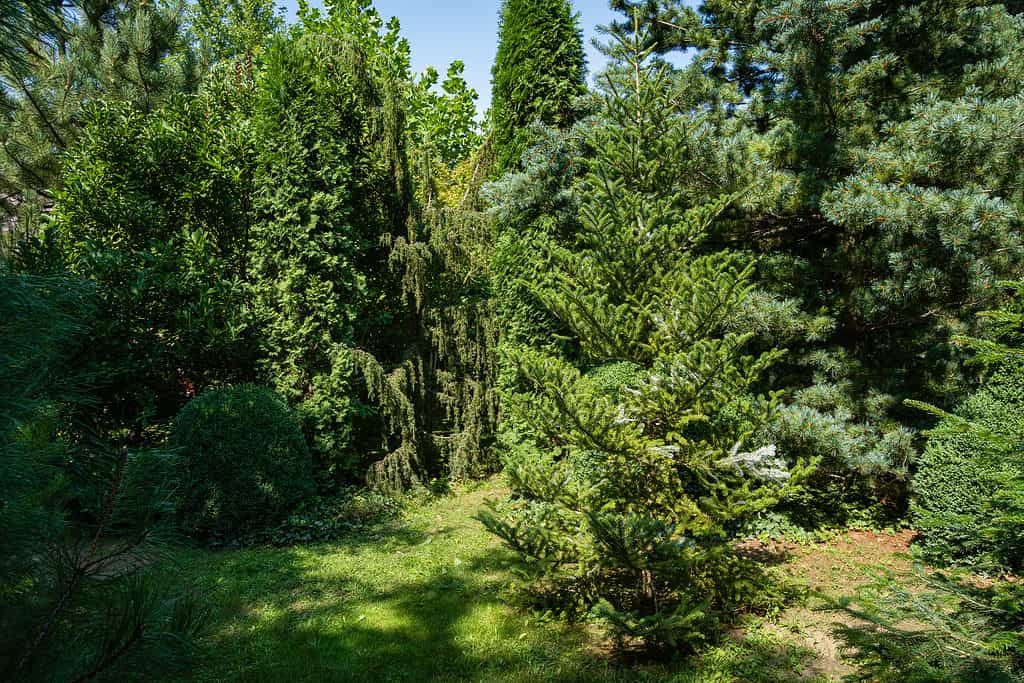
©Alexander Denisenko/Shutterstock.com
Another name for this medium sized tree is arborvitae, as it is thought to have medicinal value and arborvitae means “tree of life.” The leaves are high in vitamin C and its essential oil is used as a disinfectant and an insecticide. However, the tree also has high levels of thujone, which is toxic.
The northern white cedar usually grows to about 49 feet tall. Its bark is reddish brown and peels off in strips. The branches are arranged in fans, and the needles are flat and scaly, with seed cones that start yellowish green and turn brown as they mature. They hold about eight seeds.
You’ll find the northern white cedar growing in wet areas, especially swamps. This gives it its other name of swamp cedar. It’s not unheard of to see the tree growing out of rocks or clinging to cliffs. This tree has an even longer life span than the red cedar or the eastern hemlock, as specimens have been found that are well over 1,000 years old. The trees are able to live this long despite poor conditions and being stripped of their evergreen foliage by deer during the winters.
The lumber of the northern white cedar is popular for making shingles and fence posts and was popular for making canoes and log cabins.
8. Paper Birch
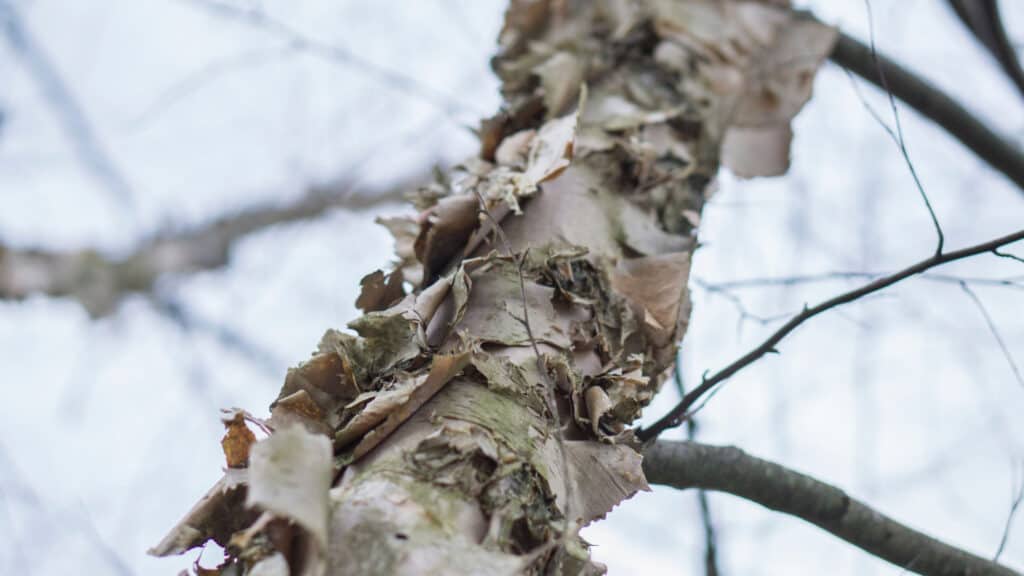
©thematthewhyatt/Shutterstock.com
The most notable characteristic of this iconic Vermont tree is its bark. Thin and white, it peels from the trunk of the tree in what looks like sheets of paper. Even though these sheets don’t deliver much nutrition, they’re a staple for moose in the winter.
The paper birch is a deciduous tree that usually grows to about 66 feet in height. The trunk may be single, especially if the tree is in a forest. The trunk is more likely to be forked if it’s grown in a garden. In contrast with cedars and hemlocks, the paper birch is notoriously short-lived. In warmer climates the tree may only live 30 years, though in Vermont’s colder climate a paper birch may live to be 100 or older. The tree isn’t particular about soil and can grow in stony soils or cold weather bogs called muskegs.
Paper birch leaves are smooth and dark green on top, and somewhat downy underneath. They’re alternate on the stem and shaped like ovals or triangles, with a round base, pointed tip, and toothed edges. The leaves turn brilliant yellow in fall and add to the beauty of Vermont’s autumn landscape.
The flowers appear in early to mid-late spring, and the tree has both male and female flowers. The female flowers are fertilized by pollen blown by the wind. Flowers are followed by winged fruit. The paper birch is often one of the first trees to arrive in an area that’s been disturbed, either by storms or wildfire.
9. Red Maple
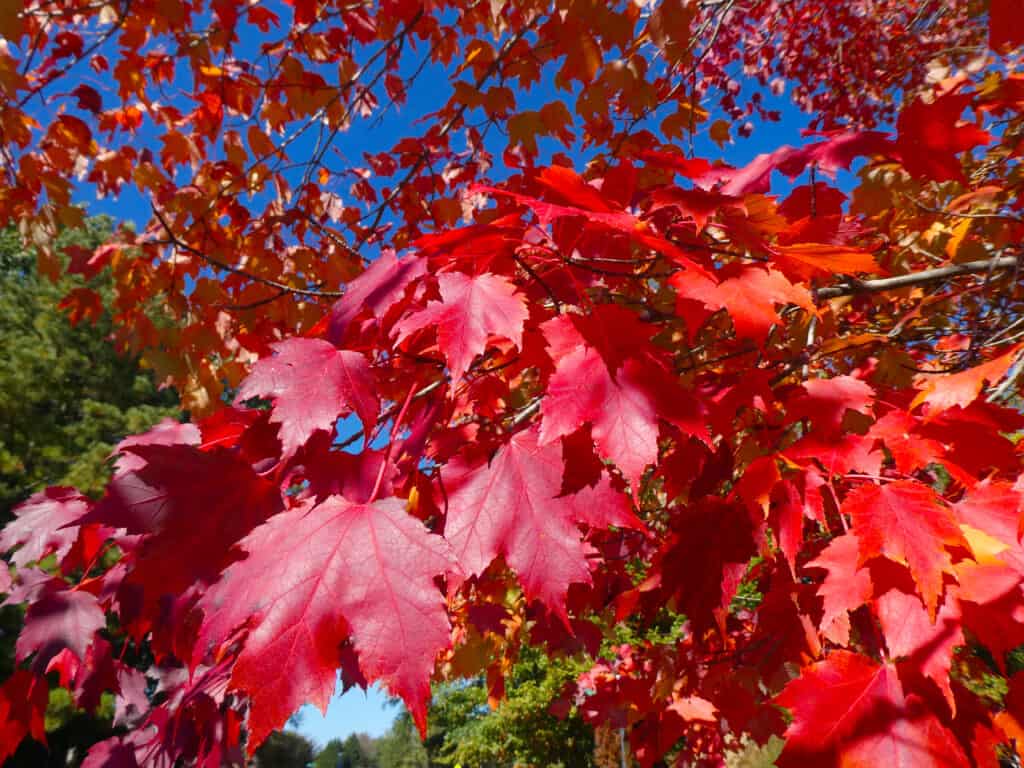
©ForestSeasons/Shutterstock.com
One of eastern North America’s most common trees, the red maple is beloved for its blazingly scarlet fall foliage. Not only are the leaves of this tree shades of red, but so are its twigs, seeds, and flowers. Even though it’s another of the iconic trees of Vermont, the red maple is the state tree of Rhode Island.
The tree, Acer rubrum, grows to around 100 feet tall and can grow in a variety of conditions. It is so adaptable that there are places where it’s considered invasive in spite of its beauty. Its leaves are opposite, around 2 to 4 inches long and palmate, with three to five toothed lobes. If the leaves have five lobes, the three at the top are larger than the two at the bottom. During the growing season, the top of the leaf is light green, while the underneath is glaucous.
The flowers appear well before the leaves. They may come as early as late winter and because they are also red, they add to the tree’s beauty. Male and female flowers often appear on different trees, and female trees tend to be more orange in the fall, while male trees are more red. The cool climate of Vermont makes the tree’s autumn foliage especially glorious.
As with all maples, the fruit of the red maple is called a samara. It can be 0.625 to 1 inch long and ripens in the spring, even before the tree has fully leafed out.
10. Northern Red Oak
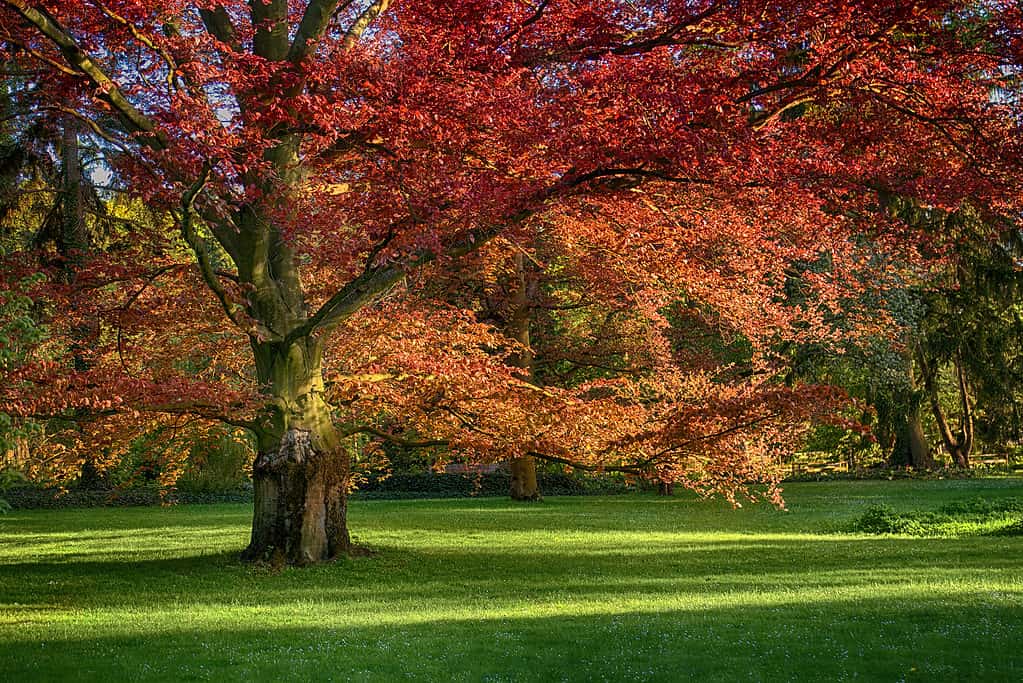
©Pawel Horazy/Shutterstock.com
This tree usually grows to around 92 feet, though some have grown considerably taller. The trunk is straight and usually has a 20-to-39-inch diameter with a ridged, striped, reddish-gray bark that differentiates it from other oaks. Its branches grow at 90-degree angles to their stems, which gives the tree a beautiful round habit.
The northern red oak is a fast-growing tree and can be 20 feet tall when it’s a decade old. It’s also long-lived, and botanists believe it can live for 400 years. The leaves are arranged alternately on the branch, are oval or oblong and have seven to nine lobes. They’re between 5 to 10 inches long and 4 to 6 inches wide. The tree doesn’t start to leaf out until there’s 13 hours of sunlight a day, no matter what the temperature is. During the growing season they’re smooth, glossy dark green, and yellow green underneath.
Red oak acorns are long ovals and can have stalks or grow straight from the branch. They have a shallow cup that only covers the base. These acorns only germinate when there’s at least three months of temperatures beneath 40 degrees Fahrenheit. They take two years to mature, and though they’re very bitter to humans they’re readily eaten by deer, birds, and squirrels.
11. Red Spruce
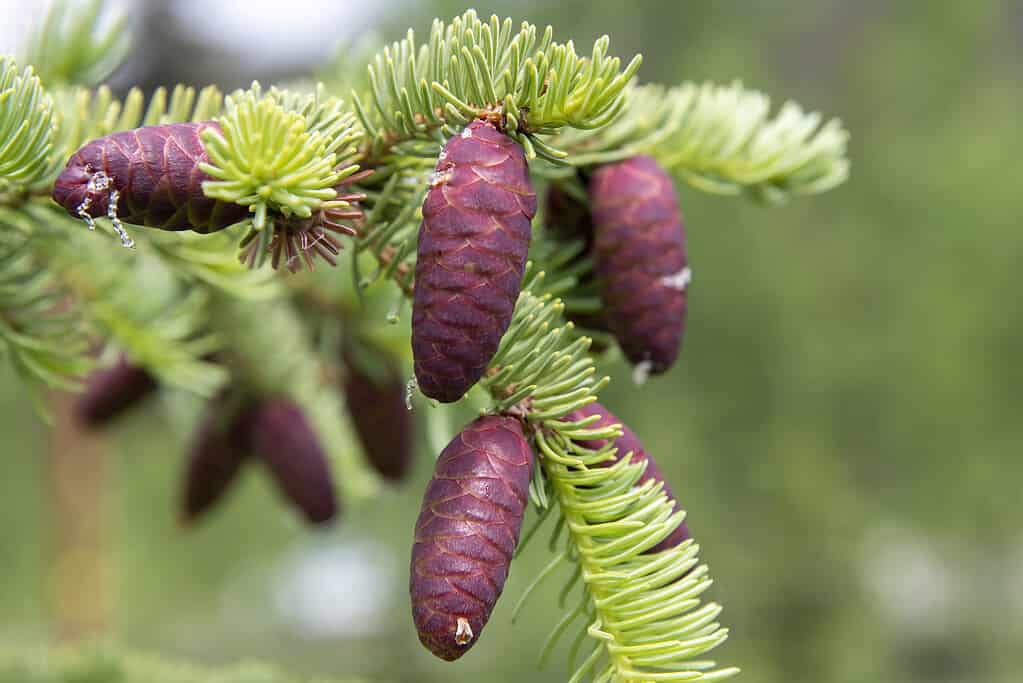
©SBWorldphotography/ via Getty Images
This coniferous tree with its conical habit is used to make something called spruce beer. Known for its shade tolerance, Picea rubens usually grows to between 59 and 131 feet tall and lives between 250 to over 450 years. Its leaves are needle-like, four-sided, green, yellow, lightly banded and emerge from all around the twig. The tree’s bark is grayish brown and breaks into small plates. The wood beneath the plates is reddish brown. The flowers arrive in May, and both male and female flowers are found on this tree. Later, the cones grow to about 2 inches long and have rounded scales. They hang down and drop from the tree as soon as they open up.
Red spruce trees are one of a number of coniferous trees used as a Christmas tree. The wood is also used to make musical instruments and for construction and millwork. People make spruce beer by boiling twigs with needles on them with sugar and spices.
12. Shadbush
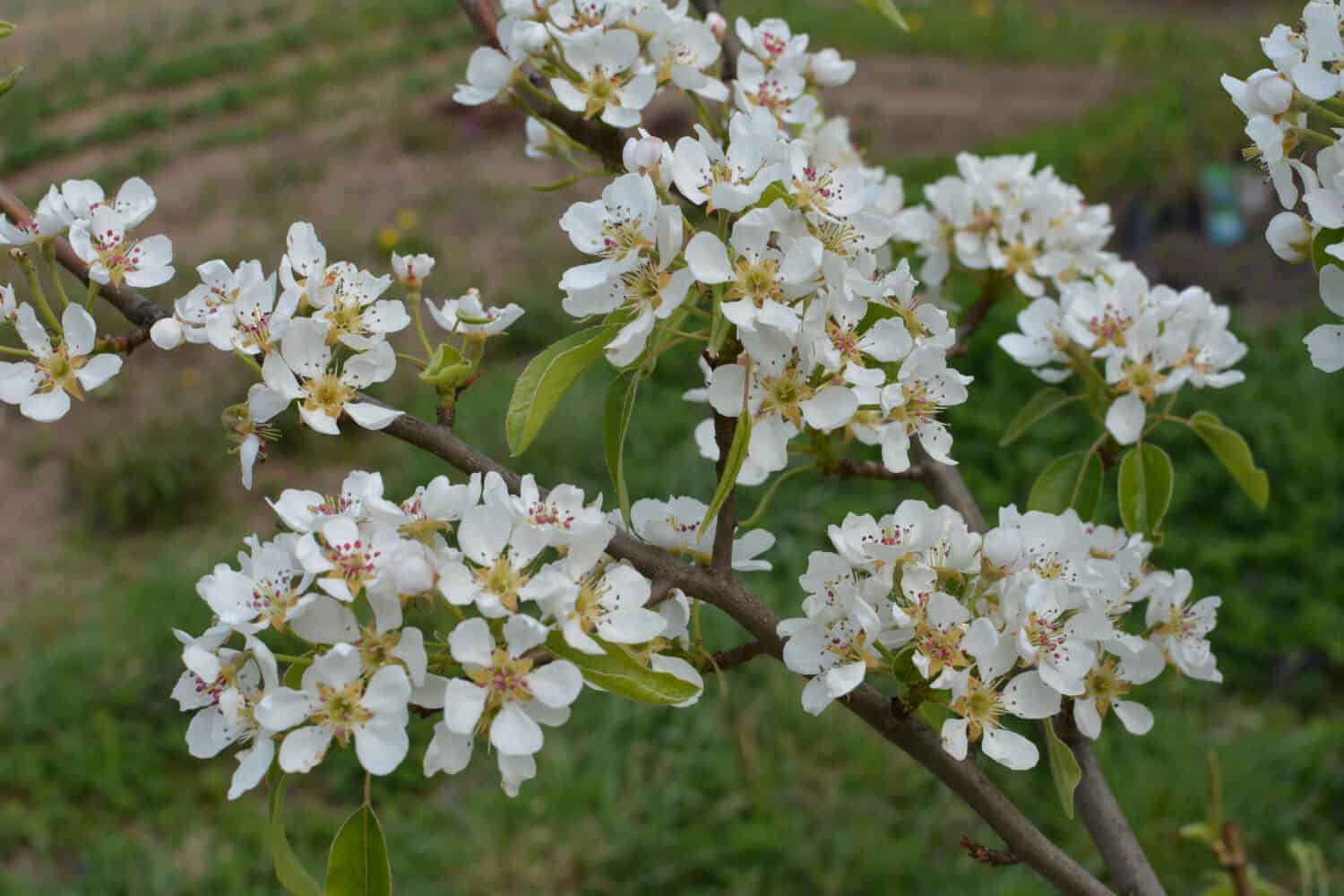
©weha/Shutterstock.com
Also called the Amelanchier or the serviceberry, this is a deciduous small tree related to the rose. It gets its name because the flowers are said to appear when the shad are running. As it grows between half a foot and 65 feet tall, the shadbush can also grow as a shrub.
The Amelanchier has gray or brown bark that’s smooth when the tree is young but fissures when it matures. The leaves are oval or lance-shaped and thin and grow on the upper part of the stem. Delicate and fragrant white flowers appear in May just as the leaves are unfurling. When they’re unfurling, the leaves are pink. The fruit appears in the summer and is red to dark purple. It’s edible and can range from not having much taste at all to being wonderfully sweet. To add to all this, the shadbush’s leaves turn scarlet in the fall.
13. Silver Maple
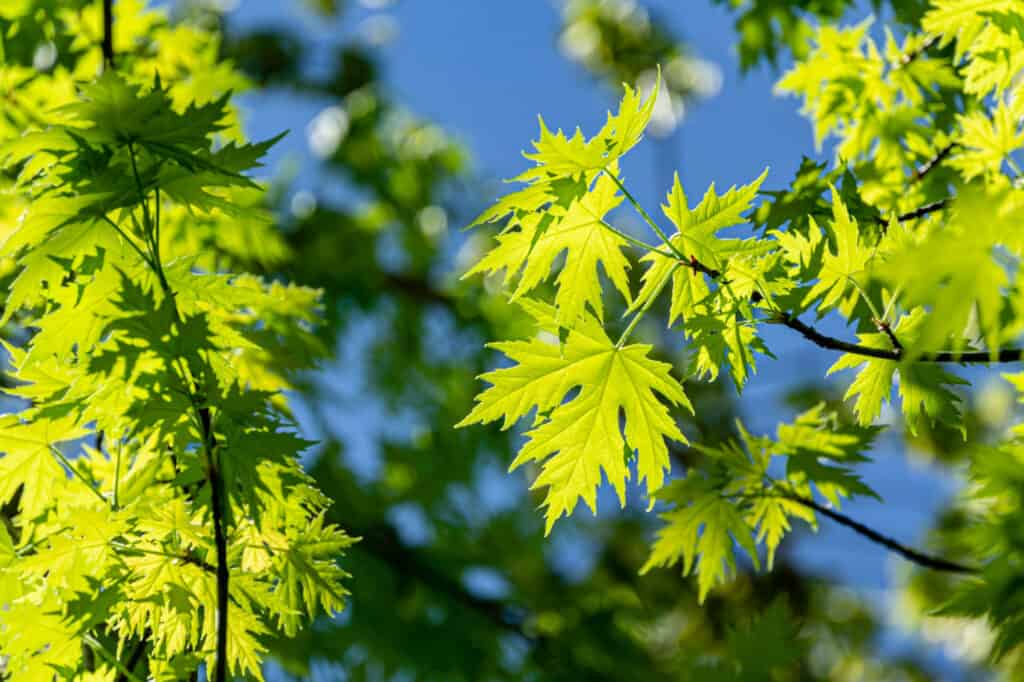
©Marinodenisenko/Shutterstock.com
This tree was given its common name because of its silvery gray bark and leaves that show their silvery undersides when a breeze blows. A commonly found tree, it usually grows between 49 and 82 feet high and has a 36-to-49-foot spread. The silver maple is a fast-growing tree, and a 10-year-old could be as tall as 26 feet.
The silver maple flourishes in wet areas and near bodies of water. When it’s young, its bark is silvery and smooth. It becomes shaggy as the tree gets older. Often, the bark presents suckers and shoots. The leaf is palmate with five lobes with deep notches between them. Their autumn colors aren’t as spectacular as the leaves of other maples. Usually, silver maple leaves turn pallid yellow or red. They also drop earlier than the leaves of other maples.
Silver maple flowers arrive in clusters and open in March, before the leaves. The samaras each have one seed and are larger than the samaras of other maples found in Vermont. Because they’re so large, the silver maple’s samaras are taken away by water instead of wind. The tree is also unusual in that it produces its fruit in the spring. The only other maple that does that in Vermont is the red maple. The seed also sprouts immediately after it finds a suitable place to grow.
Like other maples, the silver maple can be male, female or both. It can also change from one sex to the other, and it starts producing seeds when it’s about 11 years old. Its wood is used for pulp, furniture, flooring, and musical instruments.
14. Sugar Maple
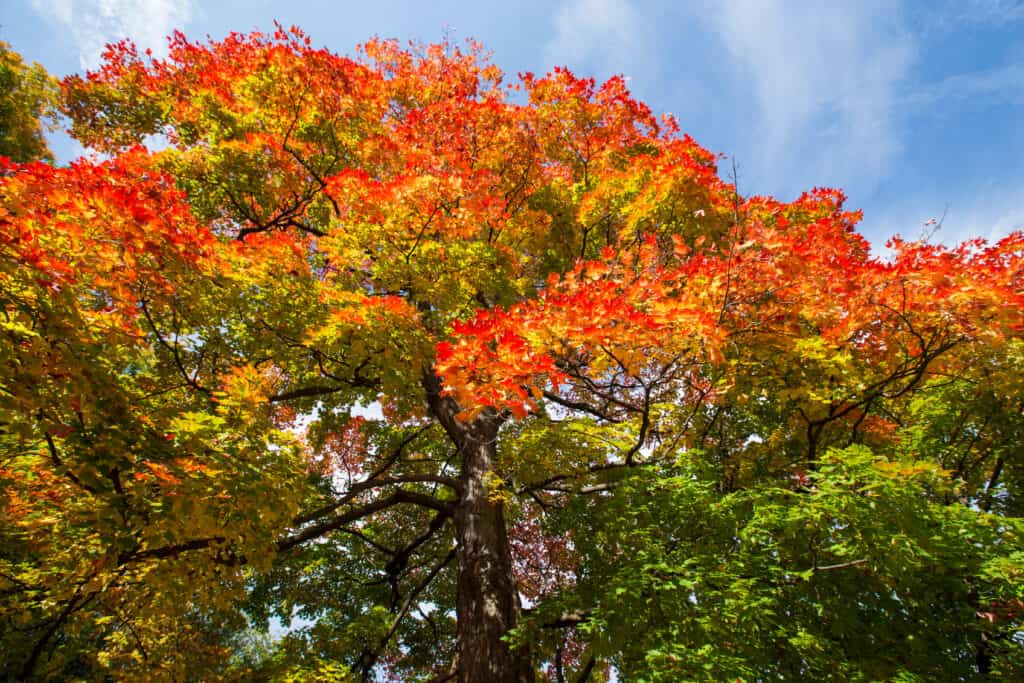
©Mircea Costina/Shutterstock.com
The silver maple and the sugar maple have curiously similar scientific names (silver maple is Acer saccharinum while the sugar maple is Acer saccharum). They’re both iconic trees in Vermont, but the sugar maple is not only the tree that provides syrup but is the state tree of Vermont. You can find it on the state quarter. It also provides amazing fall foliage and beautiful figured wood.
Usually, the sugar maple grows between 80 and 115 feet, and there are trees noteworthy for their large spread and the diameter of their trunks. Like other maples, it has palmate leaves, but the notches between the lobes aren’t as pronounced as they in the leaves of the silver maple. The bark of an older tree is grayish brown and shaggy.
Flowers, Samaras, Wood
Sugar maple flowers open in April in clusters. They’re found on stalks and lack petals. The tree can start to produce flowers when it’s about 10 years old, but others wait till they’re about 200 to flower. This is often near the end of the tree’s life, though sugar maples can live to be 300. The tree also has deeper roots than other maples and can pull water up from deep in the earth.
The sugar maple is also unlike the silver or red maple in that its samaras arrive in the fall, and in order to germinate they need to be exposed to at least 45 days of temperatures lower than 39 degrees F. Even then, the seeds won’t germinate until spring after the last frost date, but they won’t germinate if the temperature goes over 50 degrees F. The tree itself needs to endure a hard freeze to go dormant.
Besides its syrup, the tree is loved for its fall colors and its beautiful wood. Leaves turn gold, brilliantly yellow, red, orange, or a sizzling reddish orange. Often, they don’t all color at once, and one part of the tree can display fall foliage even while another part is still green. Moreover, there are some trees where all of the above-mentioned colors appear simultaneously.









